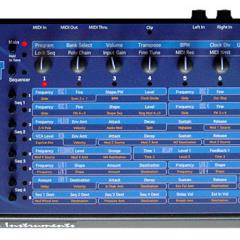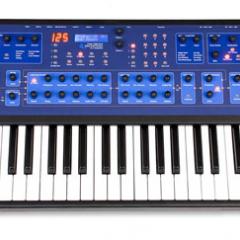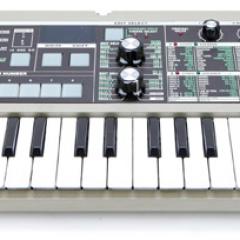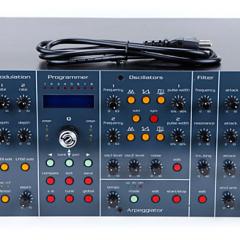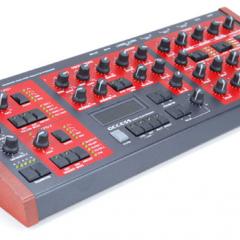Dave Smith Instruments Poly Evolver Rack

The big follow-up to Dave Smith's original Evolver, the Poly Evolver Rack, is essentially four Evolvers in a single rack space. It can be a four-voice poly synth, four mono synths (each with its own sequencer), or any combination in between. The Evolver series ressurects some of the oscillator, filter and other component technlogies from the classic Sequential Circuits Prophet-VS and Pro-One synths. The Evolver was a huge hit the moment it appeared and this Rack model is the first polyphonic version of the little beast.
Each voice is a complete Evolver with four oscillators per voice: two analog and two digital - it's a true analog/digital hybrid synth. The analog oscillators feature multiple classic waveforms plus pulse-width modulation and hard sync, and they sound really nice and big. The digital oscillators feature FM synthesis, Ring Modulation and 96 Prophet VS wavetables plus 32 user wavetables (loaded via MIDI only). Each voice also features two Curtis voltage-controlled analog low-pass filters which are fully resonant and switchable for two- or four-pole operation, two digital highpass filters and real analog VCAs. Modulation capabilities are handled by four LFOs and three ADSR envelope generators (for the filter, the amp, and one is user assignable). There are dedicated onboard effects (feedback, delay, distortion, glide, etc.). One of its best features is the MIDI-syncable 16-step 4-parameter analog-style sequencer (with each patch having its own sequence) which really brings things to life with evolving sounds. The LFOs, step sequencer, and three separate delays can all be synced for massive, rhythmic, time-based effects in stereo. A major unique feature of the Evolver is its true stereo signal path. For each Evolver voice, the left and right channels get their own independent analog oscillator, lowpass filter, highpass filter, VCA and effects. This allows for pretty nice stereo imaging effects.
The Poly Evolver Rack essentially quadruples all those Evolver specs! In Program mode, all four voices play the same sound. In Combo mode, voices can be allocated however desired: stack all 4 for a huge unison sound, split or layer the keyboard in any configuration, and/or play one or all sequences at the same time. Each voice can also respond to a different MIDI channel. Each voice has its own stereo output jacks in addition to the mix output. Stereo audio input can be routed to any or all of the voices, enabling parallel audio processing of external stereo or mono signals. The output of one voice can be routed to the input of another for interesting double-processing effects. And multiple Poly Evolvers can be daisy-chained for increased polyphony!
Full of hundreds of jaw-dropping preset patches, the Poly Evolver Rack offers four times the punch of the original Evolver. But it's not intended for performance oriented synth tweakers. It's designed to sit in a studio, tethered to your computer-MIDI set-up. Fortunately, Poly Evolver Racks ship with the Soundtower editor/librarian for both Windows and Mac OS X, but other programs such as Motu Unisyn can also be used to access, edit and control all the parameters and features of the Poly Evolver Rack. If you are more of a knob fiddler, the Poly Evolver is a fully programmable 5-octave semi-weighted keyboard version of of the Rack model, with 77 endless-turn knobs and 59 switches. It's a fantastic synth but the Rack model gives you all the same sounds and power, without all the knobs and hands-on controls, at a much lower price.
Demos & Media

Specifications
2 digitally controlled analog oscillators (DCOs) with selectable sawtooth, triangle, saw/triangle mix, and pulse waves (with pulse-width modulation), and hard sync;
2 digital wavetable oscillators with Prophet VS waves and wave sequencing capability, FM and ring modulation.
White noise generator.
4 LFOs per voice, with sawtooth, triangle, ramp, pulse, and random waves. Each LFO can be routed to any destination in the matrix. Can sync to MIDI clock.
2 digital 4-pole Highpass filters per voice.
Dual (left and right channel) tunable feedback loops with "Grunge": use feedback as a pitched sound source.
Distortion! Digital, one for each channel, can be placed before or after analog electronics; and "Output Hack."
Separate Glide per oscillator.
Websites of Interest
Resources
Images from Dave Smith Instruments
Reviewed December 2007
